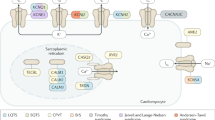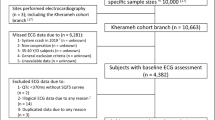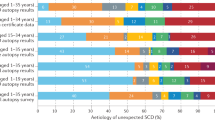Abstract
Congenital long QT syndrome (LQTS) is a genetic disorder characterized by prolongation of the QT interval on the electrocardiogram and by life-threatening cardiac arrhythmias, occurring especially during conditions of increased sympathetic activity. Existing therapies are very effective, but mortality is high among untreated, symptomatic individuals. The identification of several of the genes responsible for LQTS and the realization that they all encode cardiac ion-channels has represented a landmark finding. This advance has fostered novel genotype–phenotype studies that are providing unique insight into how close the relationship can be between molecular biology and clinical cardiology. LQTS represents a paradigm for sudden cardiac death. Indeed, the growing knowledge developed for LQTS is likely to provide the key to understanding the genetic propensity to sudden death in patients with more-common cardiovascular diseases. The data presented here illustrate how the treatment of LQTS is rapidly evolving toward a highly individually tailored approach on the basis of patient-specific genetic information.
This is a preview of subscription content, access via your institution
Access options
Subscribe to this journal
Receive 12 print issues and online access
$209.00 per year
only $17.42 per issue
Buy this article
- Purchase on Springer Link
- Instant access to full article PDF
Prices may be subject to local taxes which are calculated during checkout



Similar content being viewed by others
References
Schwartz PJ et al. (1975) The long Q-T syndrome. Am Heart J 89: 378–390
Schwartz PJ et al. (2000) The long QT syndrome. In: Cardiac Electrophysiology: From Cell to Bedside, edn 3, 597–615 (Eds Zipes DP and Jalife J) Philadelphia: WB Saunders
Moss AJ et al. (2000) Effectiveness and limitations of beta-blocker therapy in congenital long-QT syndrome. Circulation 101: 616–623
Priori SG et al. (2004) Association of long QT syndrome loci and cardiac events among patients treated with beta-blockers. JAMA 292: 1341–1344
Wang Q et al. (1995) SCN5A mutations associated with an inherited cardiac arrhythmia, long QT syndrome. Cell 80: 805–811
Curran ME et al. (1995) A molecular basis for cardiac arrhythmia: HERG mutations cause long QT syndrome. Cell 80: 795–803
Wang Q et al. (1996) Positional cloning of a novel potassium channel gene: KVLQT1 mutations cause cardiac arrhythmias. Nat Genet 12: 17–23
Splawski I et al. (2004) CaV1.2 calcium channel dysfunction causes a multisystem disorder including arrhythmia and autism. Cell 119: 19–31
Schwartz PJ et al. (1995) Long QT syndrome patients with mutations of the SCN5A and HERG genes have differential responses to Na+ channel blockade and to increases in heart rate. Implications for gene-specific therapy. Circulation 92: 3381–3386
Schwartz PJ and Priori SG (2004) Long QT syndrome: genotype-phenotype correlations. In: Cardiac Electrophysiology: From Cell to Bedside, edn 4, 651–659 (Eds Zipes DP and Jalife J) Philadelphia: WB Saunders
Schwartz PJ (1984) The rationale and the role of left stellectomy for the prevention of malignant arrhythmias. Ann NY Acad Sci 427: 199–221
Schwartz PJ et al. (1993) Diagnostic criteria for the long QT syndrome: an update. Circulation 88: 782–784
Schwartz PJ (1985) Idiopathic long QT syndrome: progress and questions. Am Heart J 109: 399–411
Moss AJ and Schwartz PJ (2005) 25th Anniversary of the international Long QT Syndrome Registry: an ongoing quest to uncover the secrets of LQTS. Circulation 111: 1199–1201
Schwartz PJ et al. (2004) Left cardiac sympathetic denervation in the management of high-risk patients affected by the long-QT syndrome. Circulation 109: 1826–1833
Schwartz PJ (1980) The long QT syndrome. In: Sudden Death, 358–378 (Eds Kulbertus HE and Wellens HJJ) The Hague: M Nijhoff
Priori SG et al. (1999) Low penetrance in the long QT syndrome. Clinical impact. Circulation 99: 529–533
Priori SG et al. (2003) Risk stratification in the long-QT syndrome. N Engl J Med 348: 1866–1874
Napolitano C et al. (2000) Evidence for a cardiac ion channel mutation underlying drug-induced QT prolongation and life-threatening arrhythmias. J Cardiovasc Electrophysiol 11: 691–696
Schwartz PJ et al. (1991) Stress and sudden death. The case of the long QT syndrome. Circulation 83 (Suppl): II71–II80
Schwartz PJ et al. (2001) Genotype-phenotype correlation in the long QT syndrome. Gene-specific triggers for life-threatening arrhythmias. Circulation 103: 89–95
Ackerman MJ et al. (1999) Swimming, a gene-specific arrhythmogenic trigger for inherited long QT syndrome. Mayo Clin Proc 74: 1088–1094
Wilde AA et al. (1999) Auditory stimuli as a trigger for arrhythmic events differentiate HERG-related (LQTS2) patients from KVLQT1-related patients (LQTS1). J Am Coll Cardiol 33: 327–332
Khositseth A et al. (2004) Identification of a common genetic substrate underlying postpartum cardiac events in congenital long QT syndrome. Heart Rhythm 1: 60–64
Zareba W et al. (2003) Location of mutation in the KCNQ1 and phenotypic presentation of long QT syndrome. J Cardiovasc Electrophysiol 14: 1149–1153
Stramba-Badiale M et al. (2000) Gene-specific differences in the circadian variation of ventricular repolarization in the long QT syndrome: a key to sudden death during sleep? Ital Heart J 1: 323–328
Zareba W et al. (1998) Influence of genotype on the clinical course of the long-QT syndrome. International Long-QT Syndrome Registry Research Group. N Engl J Med 339: 960–965
Schwartz PJ and Stone HL (1979) Effects of unilateral stellectomy upon cardiac performance during exercise in dogs. Circ Res 44: 637–645
Benhorin J et al. (2000) Effects of flecainide in patients with new SCN5A mutation: mutation-specific therapy for long-QT syndrome? Circulation 101: 1698–1706
Priori SG et al. (2000) The elusive link between LQT3 and Brugada syndrome. The role of flecainide challenge. Circulation 102: 945–947
Author information
Authors and Affiliations
Ethics declarations
Competing interests
The author declares no competing financial interests.
Rights and permissions
About this article
Cite this article
Schwartz, P. Management of long QT syndrome. Nat Rev Cardiol 2, 346–351 (2005). https://doi.org/10.1038/ncpcardio0239
Received:
Accepted:
Issue Date:
DOI: https://doi.org/10.1038/ncpcardio0239
This article is cited by
-
Inherited cardiac arrhythmias
Nature Reviews Disease Primers (2020)
-
Inherited long QT syndrome
Herzschrittmachertherapie + Elektrophysiologie (2012)
-
Participation of HERG channel cytoplasmic structures on regulation by the G protein-coupled TRH receptor
Pflügers Archiv - European Journal of Physiology (2009)
-
Congenital long QT syndrome
Orphanet Journal of Rare Diseases (2008)
-
Living with Long QT Syndrome: A Qualitative Study of Coping with Increased Risk of Sudden Cardiac Death
Journal of Genetic Counseling (2008)



